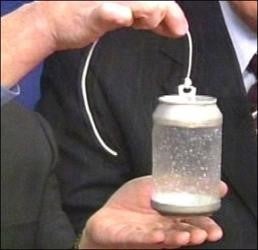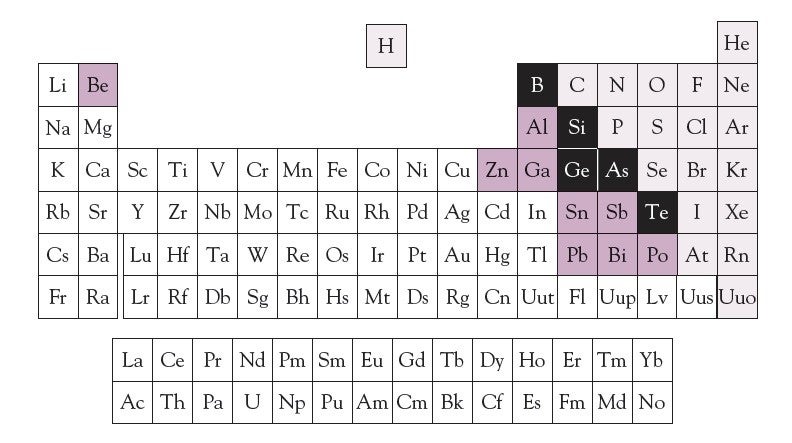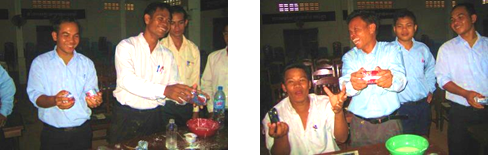Preamble
In Part 1 of this series, I showed how reagents available in a rural Cambodian market could be used for a demonstration that can be used in many contexts. In this article, the two demos use aluminum cans, sodium hydroxide, copper(II) sulfate and table salt, all of which are commonly available at a market. Aluminum cans have many uses, for example, the “collapsing can” demo to illustrate air pressure.2 Here I will describe two low-cost chemical reactions involving the cans themselves and the chemistry derived from the demos.
Layers of a soda can — what’s inside?3
An aluminum can is not just made of aluminum, but it is lined with a plastic film to prevent oxidation of the inside surface by any acid in the soft drink’s contents. In the experiment, by oxidizing the aluminum from the outside, the intact plastic lining can be seen.
This demonstration must be undertaken only by a professional in view of the hazards of working with sodium hydroxide solution. The procedure must be performed in a fume hood (or outside) and the beaker must be sitting in a non-aluminum container (plastic is fine) to catch any overflow.
After protecting the top and bottom one centimeter of an empty soda can with tape, the exposed middle section is sanded until the paint coating is eroded away and aluminum metal is clearly exposed. The can is filled with water and a piece of string is attached to the snap lid, so that the can may be lifted in and out of the reaction container. The tape is then removed and those revealed areas are covered with grease (Vaseline or motorcycle grease can be used). The can is then placed in a 500 mL beaker and 5 mol L−1 sodium hydroxide solution is carefully added around the can up to the top greased level. Extreme caution should be used when handling sodium hydroxide, and eye protection is especially important.4
Within approximately an hour, the exposed aluminum metal will all have been oxidized, and the plastic liner will be visible. The can should be carefully lifted from the solution5 and immediately placed in a large nearby container of water for a preliminary wash. The can should then be moved to a sink for further washing. With the sodium hydroxide solution totally rinsed away, the can with the exposed liner should be safe-to-handle. The can must be carefully lifted and the water inside the can may be poured out.

Fig. 1: An aluminum can with the plastic liner exposed.
In the reaction, aluminum metal is oxidized to the aluminate ion, best represented as [Al(OH)4]−(aq), though sometimes depicted as [AlO2]−(aq). The net ionic chemical reaction between aluminum metal and hydroxide ion (a good problem for balancing!) can be represented as:6
2Al(s) + 2OH−(aq) + 6H2O(l) → 2[Al(OH)4]−(aq) + 3H2(g)
A large volume of hydrogen gas is produced! For example, if 2.30 g of aluminum (0.100 mol) reacts, then at standard ambient temperature and pressure (SATP, 25°C and 100 kPa7), using the molar gas volume of 24.8 L mol−1, this will result in the production of 3.72 L of hydrogen gas.
The reaction is also very exothermic! And we can calculate the heat released from the enthalpy of formation values:
ΔfHᶿ(OH−)(aq) = −230 kJ mol−1
ΔfHᶿ(H2O)(l) = −286 kJ mol−1
ΔfHᶿ[Al(OH)4−](aq) = −1502 kJ mol−1
To give an enthalpy of reaction (per mole of aluminum) of −414 kJ mol−1.
This demo can then be turned into a discussion on the divisions in the periodic table. Each element has its own unique identity. Being scientists, we like to classify. So we divide elements into metals and nonmetals. Then there are elements sort-of in between, so we invent the category of metalloids, the elements which aren’t really either. But then we find that some metals don’t behave totally as metals. In particular, most metals and metal oxides react with acids but don’t react with bases. However, aluminum is one of the metals (and corresponding metal oxides) along the metal-metalloid border that react as vigorously, if not more so, with hydroxide ion as hydrogen ion. So they are sometimes called the weak metals.8

Fig. 2: A periodic table showing the nonmetals (pale mauve); metalloids
(black); and weak metals (dark mauve).
Ripping aluminum can^9
This demo is a variation of the same chemical reaction described in Part 1 of this series. Here, following from the above demo of showing the plastic liner, this demo shows the result of breaking the liner. The reactions are the same as those described in Part 1 of the series.
Scratch the inside of a second soda can to cut the plastic layer in the middle in one continuous horizontal line. The point of a pair of scissors or a long nail work well. Pour into the can 1 mol L−1 copper(II) chloride (or copper(II) sulfate plus table salt) solution and leave for approximately five minutes. Pour the solution out. Pull the two halves of the can apart (do not twist). Challenge the students to rip another untreated can! (The solution can be used several times by increasing the time it remains in the can.)
The chemical reactions and the learning content of this demonstration were described in Part 1 of this series of articles.
Acknowledgements
Geoff Rayner-Canham, Grenfell Campus, Memorial University, Corner Brook, NL, Canada, is thanked for working with me to develop the conceptual background to, and relevance of, the demonstrations. With special thanks from Professor Hauben, to all of the workshop assistants. There would be no workshops without you. Your excitement and joy in learning, your hundreds of hours of work in preparation and your desire to share your learning with fellow Cambodians is very inspiring. Many thanks!
References
- M. Hauben, “Showing/Doing Chemistry Using Minimum-Cost Resources, Part 1,”Chem13 News, pages 18-19, December 2013/January 2014.
- “The Collapsing Can,”http://scifun.chem.wisc.edu/homeexpts/COLLAPSE.html
- “The Disappearing Aluminum Can,” http://www.hschem.org/Laboratory/Flinn/Disappearing%20Aluminum%20Can.pdf
- “Student Safety Sheets,”http://www.cleapss.org.uk/attachments/article/0/SSS31.pdf?Secondary/Science/Student%20Safety%20Sheets/
- Disposing of the sodium hydroxide solution in a safe manner presents a challenge. It would be preferable to neutralize with an acid, but acids are difficult to find in a market. Acetic acid can be found, but it is expensive. If an acid can be found to neutralize the sodium hydroxide solution, turmeric can be used as an indicator (yellow in acid, red in base). The less satisfactory option is diluting with large volumes of water.
- This is the reaction used by many of the bubbling aluminum/sodium hydroxide drain cleaners, the hydroxide ion reacting with the fat deposits in drains. This reaction functions in two ways. The rising hydrogen gas bubbles cause circulation in the solution, increasing the contact between the hydroxide ion solution and the fat. And also the exothermic reaction heats the hydroxide ion/fat mixture, increasing the rate of reaction as rates increase with increasing temperature, clearing the blockage more readily.
- G.W. Rayner-Canham, “The New Standard State Pressure,” Chem 13 News, pages 1-2, February 1990.
- See for example, G. Rayner-Canham and T. Overton, Descriptive Inorganic Chemistry, 6th edition, pages 29-30, W.H. Freeman, 2014 — Fig. 2 reproduced by permission. It is the weak metal behavior of aluminum that allows bauxite ore (mainly aluminum oxide with iron(III) oxide) to be purified prior to the electrolytic production of aluminum metal. Hot sodium hydroxide solution reacts with the aluminum oxide, giving a solution of aluminate ion, the iron(III) oxide remaining as an insoluble sludge (‘red mud’). After filtration, cooling gives pure solid aluminum oxide.
- NCSU chemistry demo “Can Ripper,” https://projects.ncsu.edu/project/chemistrydemos/Electrochem/Can%20Ripper.pdf

Fig 3: Teacher trainees practicing the “ripping can” experiment”.







